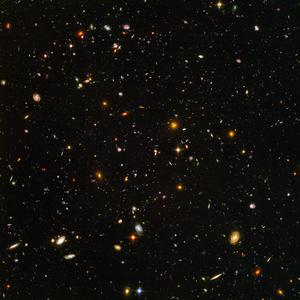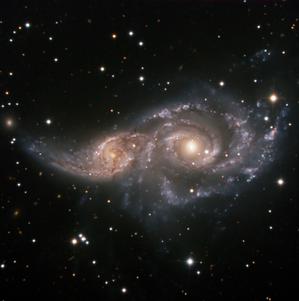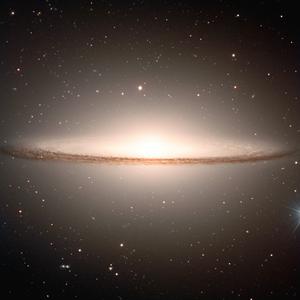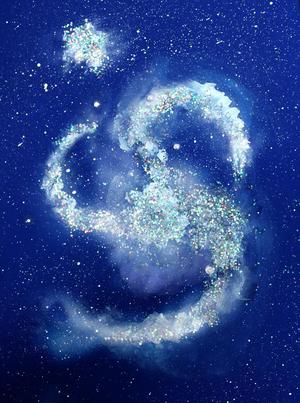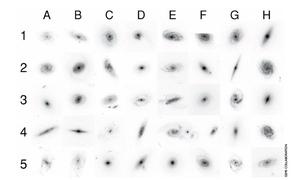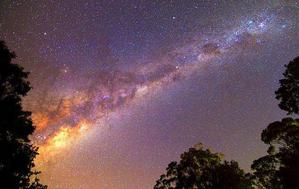Glossary term: Galaxy
Description: A galaxy is a system of stars and other material components such as dark matter, gas, and dust that is gravitationally bound, and usually separated from its neighbors by hundreds of thousands of light years. Galaxies come in various different shapes and sizes. The smallest galaxies can have a few thousand stars, while the largest can have tens of trillions. "The Galaxy" or "Galaxy" with a capital letter usually refers to our home galaxy, the Milky Way, which has around 100–400 billion stars.
Related Terms:
- Dark Matter
- Disk Galaxy
- Dust
- Dwarf Galaxy
- Elliptical Galaxy
- Galactic Bulge
- Galactic Center
- Galactic Disk
- Galactic Halo
- Galaxy Cluster
- Gas
- Greenwich Mean Time Zone (GMT)
- Irregular Galaxy
- Milky Way
- Spiral Galaxy
- Star
- Galactic Bar
- Lenticular Galaxy
See this term in other languages
Term and definition status: This term and its definition have been approved by a research astronomer and a teacher
The OAE Multilingual Glossary is a project of the IAU Office of Astronomy for Education (OAE) in collaboration with the IAU Office of Astronomy Outreach (OAO). The terms and definitions were chosen, written and reviewed by a collective effort from the OAE, the OAE Centers and Nodes, the OAE National Astronomy Education Coordinators (NAECs) and other volunteers. You can find a full list of credits here. All glossary terms and their definitions are released under a Creative Commons CC BY-4.0 license and should be credited to "IAU OAE".
If you notice a factual error in this glossary definition then please get in touch.
Related Media
Hubble Ultra Deep Field
Credit: NASA, ESA, and S. Beckwith (STScI) and the HUDF Team credit link
License: CC-BY-4.0 Creative Commons Attribution 4.0 International (CC BY 4.0) icons
Spiral Galaxy Merger
Credit: ESO credit link
License: CC-BY-4.0 Creative Commons Attribution 4.0 International (CC BY 4.0) icons
Sombrero galaxy
Credit: ESO/P. Barthel credit link
License: CC-BY-4.0 Creative Commons Attribution 4.0 International (CC BY 4.0) icons
Related Diagrams
Leo Constellation Map
Credit: Adapted by the IAU Office of Astronomy for Education from the original by IAU/Sky & Telescope
License: CC-BY-4.0 Creative Commons Attribution 4.0 International (CC BY 4.0) icons
Related Activities
Glitter Your Milky Way
astroEDU educational activity (links to astroEDU website) Description: Explore the Milky Way and characteristics of galaxies using glitter drawing.
License: CC-BY-4.0 Creative Commons Attribution 4.0 International (CC BY 4.0) icons
Tags:
Art
, Creativity
, Hands-on
, Handcraft
Age Ranges:
6-8
, 8-10
Education Level:
Middle School
, Primary
Areas of Learning:
Fine Art focussed
Costs:
Medium Cost
Group Size:
Group
Skills:
Communicating information
Coma Cluster of Galaxies
astroEDU educational activity (links to astroEDU website) Description: The basics of galaxy classification, using Hubble Space Telescope images.
License: CC-BY-4.0 Creative Commons Attribution 4.0 International (CC BY 4.0) icons
Tags:
Coma Cluster
Age Ranges:
14-16
, 16-19
, 19+
Education Level:
Secondary
, University
Areas of Learning:
Guided-discovery learning
Costs:
Low Cost
Duration:
1 hour
Group Size:
Group
Skills:
Analysing and interpreting data
, Communicating information
, Constructing explanations
, Planning and carrying out investigations
Living in the Milky Way
astroEDU educational activity (links to astroEDU website) Description: Build a model of the Milky Way to discover what our galaxy contains.
License: CC-BY-4.0 Creative Commons Attribution 4.0 International (CC BY 4.0) icons
Tags:
Hands-on
, Model
Age Ranges:
6-8
, 8-10
Education Level:
Primary
Areas of Learning:
Problem-solving
, Social Research
Costs:
Medium Cost
Duration:
1 hour 30 mins
Group Size:
Group
Skills:
Asking questions
, Communicating information
, Developing and using models
